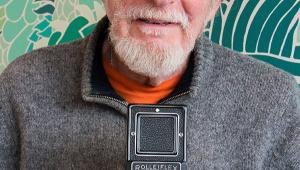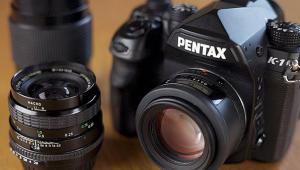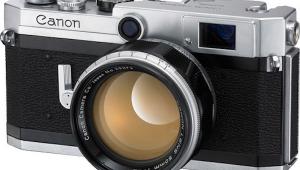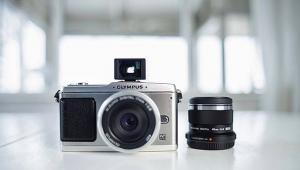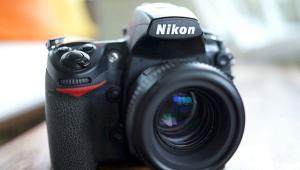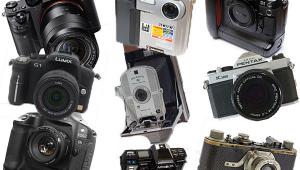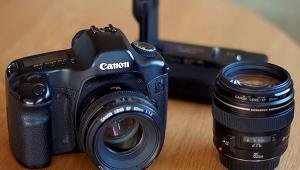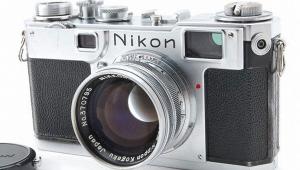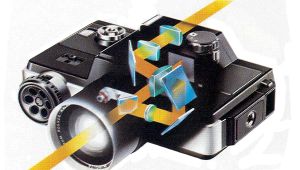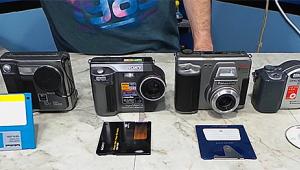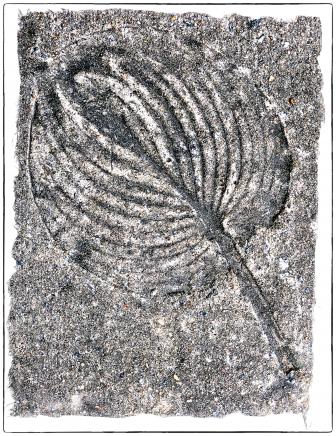Our Top 10 Favorite Classic Cameras: The Best Buys
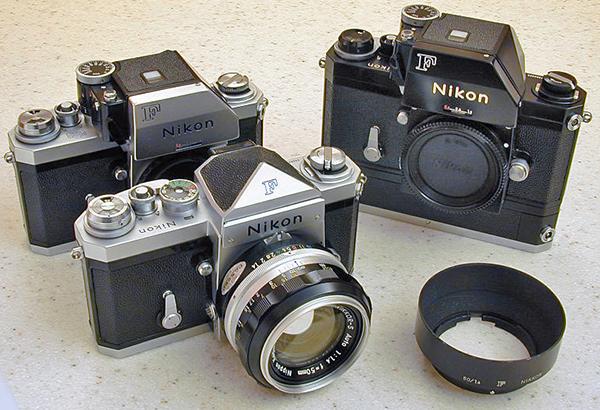
The 10 classic cameras on this list are all beautiful objects capable of taking superb pictures. They’re also outstanding examples of brilliantly integrated camera design, and each in its own way is a technological masterpice.
To make things a little more interesting for my fellow user-collectors, I decided to add another criterion in formulating this list—namely, value. In short, each one of the classic cameras below qualifies as a legitimate Best Buy. And I put my money where my mouth is, by doing extensive hands-on research, and then actually plunking down my hard-earned cash for each and every camera detailed below!
Here’s some sage advice for buyers of classic (and used) cameras:
- Check the dealer’s reputation before you pull the trigger, especially if it’s a private or eBay sale.
- Get a full money back warranty or return privilege, preferably in writing.
- Check all the camera’s functions as soon as you receive it , or in the store.
- If it’s a film camera, shoot a roll ASAP so you can see actual results and return the camera within the return period.
Topcon Super D

Introduced in 1963 by Tokyo Opyocal Co. as the Topcon RE Super and sold in the U.S. as the Beseler Topcon Super D and DM until the ‘80s, it was the first 35mm SLR with through-the-lens match-needle metering, using CdS meter cell built into the mirror. Hefty, robust, and beautifully made, the pro-caliber Super D features an Interchangeable eye-level pentaprism and finder screens, full-aperture metering, cloth focal-plane shutter with speeds from 1-1/1000 sec plus B, and winder/motor compatibility. Its Exakta-compatible bayonet mount R.E Auto-Topcor lenses are outstanding and highly esteemed.
Price: $200-$350 with 58mm f/1.4 or f/1.8 Topcor lens
Olympus OM-1

The camera that sparked the ultra-compact 35mm SLR revolution when it debuted in 1973, the jewel-like OM-1 is an exquisite, beautifully made, through-lens-metering, match-needle SLR. It features a cloth focal-plane shutter with speeds from 1-1/1000 sec plus B, a two-CdS cell metering system, a fixed pentaprism with interchangeable viewing screens, mirror lock-up and motor/winder compatibility. An extensive system of excellent Zuiko lenses (8mm to 1000mm) and accessories were available.
Price: $50-$150 with 50mm f/1.8 Zuiko lens, $200 with 50mm f/1.4 Zuiko lens: Note: the ulimate OM-series camera is the advanced auto-exposure OM-4Ti, but that will set you back $400-500, body only
Konica Autoreflex T3
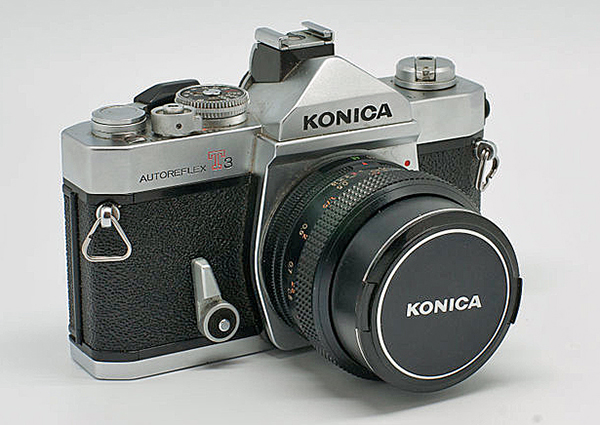
The Konica Autoreflex T of 1968 was the first 35mm SLR in the world with through-the-lens (TTL) fully automatic exposure control. It’s successor, the T3 of 1973, is a robust, substantially upgraded, more refined version of this shutter-priority-metering classic that added a depth-of-field preview, double-exposure capability, a wider range of film-speeds (ISO 10-3200), and and a brighter viewing system with apertures and shutter speeds visible in the finder. Other features: a metal, vertical-travel Copal Square shutter with speeds from 1-1/000 sec plus B, fixed eye-level pentaprism, and a superb line of Hexanon lenses in Konica AR bayonet mount.
Price: $50-150 with 50mm f/1.4 or 50mm f/1.7 Hexanon lens
Pentax Spotmatic F
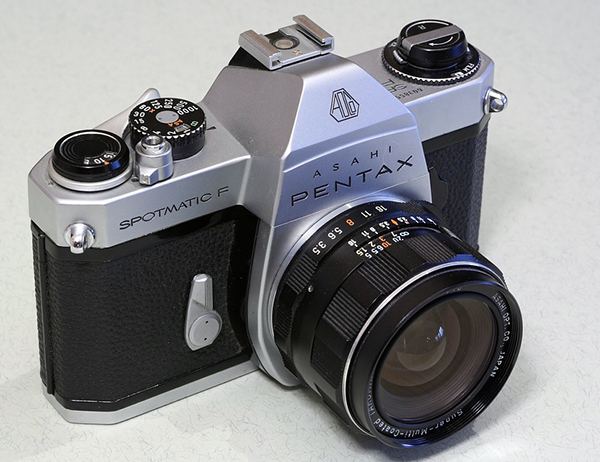
The original Spotmatic of 1964 pioneered the modern TTL metering system for 35mm SLRs—it takes exposure readings off the finder screen. In other respects, the Spotmatic was quite conservative, providing match-needle CdS metering only at working aperture and using the traditional 42mm threaded Praktica mount. Thanks to its good looks, excellent reliabilty, and outstanding imaging performance it became one of the hottest-selling, most influential SLRs of its era. It was eventually developed into the similar-looking, full-aperture-metering Pentax Spotmatic F of 1974 that also features a cloth focal-plane shutter with speeds from 1-1/1000 sec plus B, but is much more convenient to use. Screw mount Takumar and SMC Takumar lenses for the Spotmatic F will give the latest optics a run for the money.
Price: $50-150 with 55mm f/1.8 or 50mm f/1.4 Super-Takumar lens. Similar models to consider: the Pentax SP and classic K1000
Nikon F
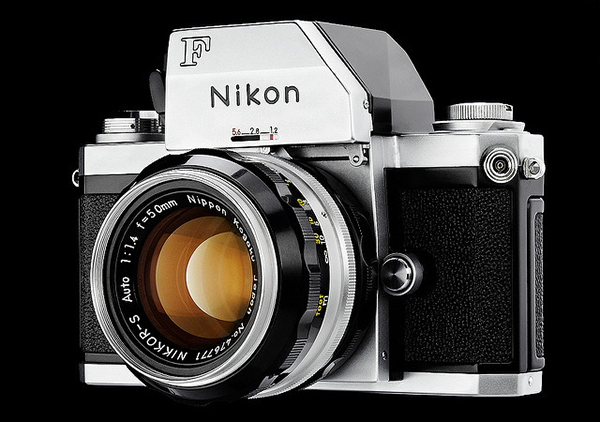
The legendary Nikon F that debuted in 1959 was the first truly professional caliber 35mm SLR and the heart of a high quality professional SLR system. It remained in production, with relatively minor changes, for nearly 14 years, and was the leading professional 35mm camera of its era. A handsome, rugged, and reliable camera, its modular design with removable pentaprism and external meter-coupling system allowed users to add the lastest metering technology by aquiring a new meter prism. Its F mount has endured, with some operational changes, to the present digital era. Key features: a titanium foil focal-plane shutter (early models had cloth shutters) with speeds from 1-1/1000 sec plus B and T, interchangeable finders and screens, and a removable back. The Nikon F is a superb and affordable user-collectible and its Nikkor lenses are legendary.
Price: $100, body only with Photomic FT or FTN meter prism, same with 50mm f/1.4 or f/2 Nikkor lens, $150-200
Leica M9
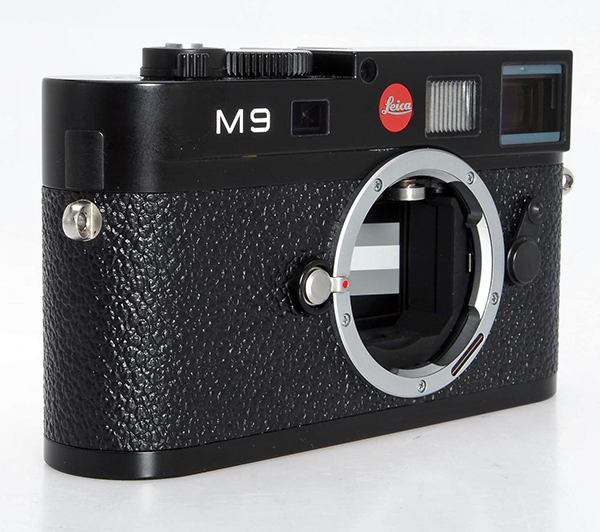
Manufactured from 2009 to 2012, the Leica M9 was the first full-frame digital Leica M. While this 18.5-MP classic has been surpassed by the latest Leicas including the posh M10, it’s still a classic user-collectible with a superb 0.68x range-viewfinder that automatically displays 6 auto-indexing parallax-compensating frame-lines in pairs—35 and 135 mm, 28 and 90 mm, or 50 and 75 mm. The M9 also provides metered manual exposure, and aperture-priority TTL auto-exposure with a center-weighted or averaging pattern, has ISO settings 80-2500, a 2.5-inch, 230,000-pixel LCD, and a vertical travel metal focal plane shutter with speeds on 32-1/4000 sec. While the M9 is pricey, it still qualifies as a “great buy classic” that delivers outstanding performance with Leica’s unsurpassed M-series lenses.
Price: $2,800-$3,200, body only
Leica M3

This brilliantly innovative design set a new standard for Leica and many experts consider it the finest interchangeable–lens 35mm rangefinder camera ever made. Introduced in 1954, it remained in production until 1966. Early models featuring double stroke lever-type film advance are a bit more affordable. All M3s incorporate a Leica M bayonet mount, and a superb combined coincident-type 0.91x range-viewfinder with projected, parallax-compensating auto-indexing frame lines for 50mm, 90mm, and 135mm lenses, and most have a built-in mechanical self-timer. Around 220,000 M3s were produced, so it’s readily available but models in pristine condition fetch fancy prices.
Price: double-stroke, $850-$1,200, body only, chrome: $950-$1,400 single-stroke, body only.
Rolleiflex MX EVS

The epitome of the non-interchangeable-lens 2-1/4-inch square (6 x6 cm format) twin-lens reflex, this mid ‘50s masterpiece is a thoughtfully upgraded version of the Rolleiflex Automat of 1937, one of the most brilliantly innovative camera designs of all time. It provides automatic first-frame positioning, film advance and automatic frame counting via a single-stroke film-wind crank, and automatic shifting-frame parallax correction over the entire focusing range. The MX EVS adds modern coated lenses (a 75mm f/3.5 Carl Zeiss Tessar or Schneider Xenar), a Synchro-Compur 1-1/500 sec plus B shutter with full flash sync and built-in self-timer, EVS settings on the aperture and shutter speed dials, and brighter focusing screens. The result is a timeless classic that offers exceptional imaging performance in an iconic form factor. Later Rolleiflex models with f/3.5 and f/2.8 Zeiss Planar and Schneider Xenotar lenses are also great user-collectibles but they command much higher prices.
Price: $300-650 with Tessar or Xenar lens
Konica IIIA

The Konica IIIA of 1958 may well be the best, and one of the best looking, non-interchangeable-lens 35mm rangefinder camera ever made. Major upgrades from the Konica III: a brilliant high-magnification, 1:1 range/viewfinder, with projected white frame lines that not only correct for parallax error but also compensate for changes in frame field size (the decrease in angular coverage as you focus closer.) The signature vertical double-stroke film advance system was retained. The original IIIA sported the acclaimed 48mm f/2 Hexanon lens but buyers soon had the option of a 50mm f/1.8 Hexanon, said to be a tad sharper, at slightly higher cost. Both variants featured a Seikosha-MXL shutter with speeds of 1-1/500 sec plus B, and built-in LV system.
Price: $120-200 with 48mm f/2 or 50mm f/1.8 Hexanon lens
Mamiyaflex C330, C330f, and C330S Professional

The final and most advanced versions of Mamiya’s long line of 6x6cm interchangeable twin-lens reflex film cameras, the pro-caliber C330 introduced in 1969 was significanly lighter than the previous model C33, and it had a parallax indicator for accurately framing shots taken at close distances. It was succeeded by the C330 which takes 120 or 220 roll film, has a self-cocking single-throw 360° film-wind crank with double-exposure prevention, interchangeable finder screens and a redesigned parallax indicator that includes settings for 55mm, 65mm, and 250mm lens sets, The C330f released in 1972 added a focus-lock lever, and the last Mamiyaflex, the C330S of 1983, is even lighter in weight, and has a single-action waist-level finder that’s easier and faster to open. Any C330 is a superb and affordable classic TLR and the entire lens line, including the outstanding 5-element 80mm f/2,8 Mamiya-Sekor normal prime, delivers superb image quality.
Price: C330, $200-400; C330f, $300-450; C330S $500-600, all with Mamiya-Sekor 80mm f/2.8 lens set


